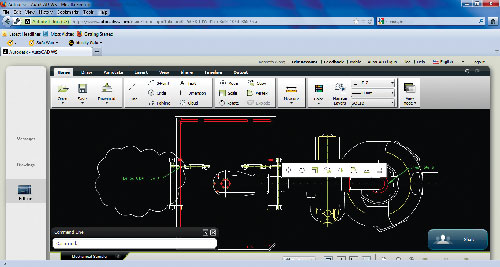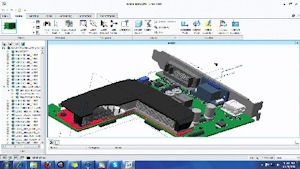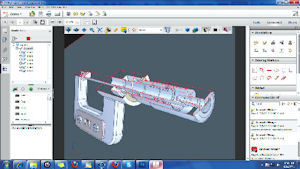Latest News
May 1, 2012
By Kenneth Wong
Your job as a design engineer may end with the delivery of your 3D CAD files to the manufacturer, but not so for your CAD files. They continue to serve as the basis for photorealistic renderings in a glossy product catalog, illustrations in an instruction booklet, or web-hosted movies showing how to remove the internal components of your assembly. Sometimes, even before you have finalized your design, you may need to share it with others so they can produce certain assets that are ready when the product ships.
Those who are expected to work with your design may have little or no CAD exposure. For effective reuse of your design, you need to provide it to them in an appropriate format, with enough information for them to do what they need to do. Here are a few basic rules to guide you through the neutral-file jungle.
DWG Rules
Many engineers and designers have migrated from their 2D drafting systems to 3D mechanical CAD programs. But for legal contracts and paper archives, 2D is still preferred. The dominant format is DWG, the standard output of Autodesk’s AutoCAD. It’s also possible to use IntelliCAD Technology Consortium’s and Open Design Alliance’s technologies to produce DWG files.
 |
| AutoCAD WS, available for free from Autodesk, lets you view, edit and annotate DWG files from a browser, effectively eliminating the need to install a professional software title (such as AutoCAD) to interact with the popular 2D format. |
The format is widely supported by 3D CAD programs, both for import and export, because CAD users must still deal with design documents saved as 2D drawings over the years.
In the last five years or so, several drafting programs that cost less than AutoCAD have emerged—giving you a way to read, edit and even create from scratch DWG files. The list includes IMSI/Design’s DoubleCAD XT (free, with the option to upgrade to a professional version); Dassault Systemes’ DraftSight (free, runs on Windows, Mac, and Linux); and Gräbert’s ARES ($795, runs on Windows, Mac, and Linux). SolidWorks offers the free desktop DWG viewer, eDrawings; Autodesk’s AutoCAD WS, available for free, gives you the ability to view, edit, and share DWG files from a browser window; and IMSI/Design’s TurboViewer, also free, brings viewing functions to mobile devices. Bentley Systems and Autodesk software can read and write each other’s formats. Bentley’s free Bentley View software, for instance, lets you read not just Bentley’s DGN format, but also Autodesk’s DWG files.
3D Exchange of Competing CAD
Say what you will of the CAD vendors and their fierce rivalry, but you must give them credit for doing a fairly good job at enabling interoperability. Many programs can now, in fact, read parts and assemblies from competing vendors’ programs.
For instance, you may open an Autodesk Inventor file in SolidWorks, and you may also open a SolidWorks file in Inventor. But because of the different geometry kernels they license and employ, and variations in the way they process and translate 3D data, you may need to apply fixes and healing operations to complex surfaces post-import.
Almost universally, major 3D CAD packages support neutral formats, such as IGES, STEP, JT, STL, ACIS and Parasolid. They serve as an intermediary step when sending the original CAD file is not possible (the recipient doesn’t have a way to open it) or advisable (you have concerns that your design could be reverse-engineered). They offer the recipient the meat of your design—its geometric shape, mass, volume and a limited understanding of its substructure—but not the recipe to your design, so to speak.
Among these formats, STL has emerged as the standard for 3D printing. With this format, you may send your design to a service bureau or use a 3D printer (from Objet, 3D Systems or Stratasys, for example) to literally turn your digital design into solid shape. Being a collection of meshes, STL is also widely used for simulation and analysis.
Finite element analysis (FEA) experts who study and analyze 3D digital design files for stress resistance, load capacity, thermal performance and other simulated tests are not necessarily CAD software experts. Furthermore, a CAD file often contains far more information (feature history, manufacturing information, etc.) than FEA experts need. They need, most of all, the basic geometry of the design, preferably with insignificant details stripped out. For these reasons, STL—or another neutral format—is usually requested for analysts.
Initially developed by Siemens Product Lifecycle Management (PLM) Software, JT has been accepted by the International Organization for Standardization (ISO).
“Any company working with 3D digital product data in a heterogeneous environment requiring interoperability between internal departments or with external suppliers and partners can benefit from the use of JT,” notes Bruce Feldt, vice president of Open Tools, Siemens PLM Software. “And now that its documentation has become an official ISO publication, JT is reinforced as the benchmark for openness in the PLM domain—paving the way for virtually any manufacturer to adopt JT as their common enterprise format for 3D workflows and long-term data retention.”
 |  |
| PTC Creo MCAD View, an independent app, lets you view PTC Creo CAD formats, neutral 3D formats and native CAD file formats from other vendors. | With the formation of the 3D PDF Consortium, Adobe’s 3D PDF is poised to become a popular format for transmitting interactive 3D documents. Shown here is Acrobat X Professional with Tetra 4D’s plug-in, allowing you to create 3D PDF documents. |
Rendering for Engineers
Photorealistic rendering or ray-traced rendering is often the domain of film, game, digital content creation and media industries, but the rise of a new crop of rendering programs targeting casual users has made it possible for engineers untrained in high-end rendering and animation software (such as Autodesk 3ds Max, Maya or Alias) to easily churn out renderings from CAD files.
Such CAD-friendly rendering packages—Luxology’s modo 601 with CAD loaders, Luxion’s KeyShot, Bunkspeed’s SHOT, and Dassault Systemes’ 3D VIA Composer, to name but a few—can accept and work with native CAD formats, such as Autodesk Inventor, SolidWorks and Solid Edge files. However, users may find that, because of size and complexity, working with native CAD files may make the software less responsive.
By contrast, loading the design as a neutral file format (IGES, STEP) may make the software far more responsive. Because of the nature of rendering operations, formats that display the design as polygons, meshes and surfaces work best. Leading rendering packages support COLLADA, FBX, OBJ and other formats better suited for rendering.
Though not a professional design tool, Google SketchUp’s file format has also found a place in many rendering program’s import menu. The abundance of free 3D models available in the SketchUp format at the Google 3D Warehouse makes the file type attractive to beginners, casual users and those in the do-it-yourself maker community.
Tech Pub, Markup and Mobile
Using a lightweight 3D file format for collaboration—usually the domain of viewing and markup applications—is a long-established market, but CAD software developers’ attempt to conquer the technical publication market, along with the rise of mobile devices, adds new twists to the old usage.
By and large, general 3D design file viewers (like Oracle AutoVue, PTC Creo View MCAD, Dassault Systemes’ 3D VIA Composer Player, and Lattice Technology’s XVL Player) support neutral formats commonly exported from CAD programs and some native CAD formats. Recently, common preference seems to have shifted from desktop and laptop machines to mobile devices in performing collaborative tasks (annotating design proposals and approving design changes, for example) and data-management operations (verifying project status, recording change history, and managing read-write privileges). The wide range of mobile apps that have recently sprung up indicates the move to lighter, portable, touch-enabled devices. It’s the Wild West of expansion in downstream 3D data use.
Most major CAD vendors, including Siemens PLM Software and Dassault Systemes, provide mobile apps that can open and view file formats associated with their primary 3D platforms. Siemens PLM Software’s Teamcenter Mobility, for instance, opens and reads JT, the preferred lightweight format exportable from the company’s Solid Edge and NX CAD programs. Similarly, Dassault Systemes’ 3DVIA Mobile and 3DVIA Mobile HD lets you access and view 3D files that are uploaded and stored in a secure cloud on 3DVIA.com. Supported formats include SolidWorks, CATIA, 3DVIA Shape, 3DXML, 3DVIA Composer and a host of other 3D formats. PTC’s newly released Windchill Mobile lets you view and interrogate Creo View MCAD models, a lightweight format used by the company’s Creo product line.
Third-party tools, like CadFaster’s QuickStep, by contrast, gives you a way to view more neutral formats (IGES, STEP, DWG, DXF and HSF). Another alternative is Titansan Engineering’s VueCAD app for iPad. It supports a number of neutral files, including IGES, STL, JT, 3ds Max and Collada. With an upgrade, the app lets you view some native formats, including SolidWorks, Solid Edge, CATIA, Pro/ENGINEER, and Autodesk Inventor.
For mobile apps addressing enterprise data management (EDM) and PLM, geometry alone may not be sufficient. The neutral format must also be able to retain and display tolerances, material specifications, supplier information, part numbers and other relevant metadata. For such applications, 3D XML, JT, and other metadata-rich formats are more suitable than strict geometric formats like IGES, STEP or STL.
With the formation of the 3D PDF Consortium, 3D PDF is also poised to become a commonly used format to deliver and communicate design changes, technical instructions and design review notes. As a format, PDF is already widely accepted, thanks to the free PDF viewer’s dominance outside engineering.
A plug-in from Tetra 4D enables Adobe Acrobat Professional users to produce 3D PDF documents with embedded annotations, animations and cross-sections, viewable by anyone with a free PDF viewer. SHARE3D, a solution from QuadriSpace, lets you create 3D PDF documents using a template-driven approach.
Courting those who may want to repurpose 3D CAD data for technical manuals, many CAD software makers are releasing their own easy-to-use technical manual publishing software titles. The lineup includes Autodesk Inventor Publisher, Dassault Systemes’ 3D VIA Composer and PTC’s Creo Illustrate. With an eye toward the same market, third-party software maker Lattice Technology also offers XVL Studio. Nearly all these programs offer an option to export the results as PDF. Because technical instructions are better delivered as animation files, these programs also offer ways to export common movie file formats.
The differences among these CAD-based tech publishing software titles may be twofold:
1. the comprehensiveness of neutral and native file formats supported; and
2. the learning curve involved in mastering the tools for producing interactive documents.
Lightweight Benefits
3D CAD files with detailed feature histories are the lifeblood of manufacturing, but they also prove too unwieldy for collaborators and subcontractors who need only a fraction of the information (usually just its basic geometry, surfaces or meshes). The primary advantage of using a neutral format is its compactness, portability (via mobile apps), and metadata-housing capacity (its ability to retain and display material info, part numbers and other attributes).
But the formats themselves, like any computer file format, are just a series of binary codes. They’re useless if they do not enjoy the support of a wide range of independent viewers and mobile apps.
Kenneth Wong is Desktop Engineering’s resident blogger and senior editor. Email him at [email protected] or share your thoughts via deskeng.com/facebook.
MORE INFO
Adobe
3D Systems
Autodesk
Bentley Systems
Bunkspeed
CadFaster
Dassault Systemes
Google
Gräbert
IMSI/Design
IntelliCAD Technology Consortium
Lattice Technology
Luxion Inc.
Luxology LLC
Objet
Open Design Alliance
Oracle
PTC
QuadriSpace
Siemens PLM Software
Stratasys
Tetra 4D
Titansan Engineering Services Inc.
Subscribe to our FREE magazine, FREE email newsletters or both!
Latest News
About the Author
Kenneth Wong is Digital Engineering’s resident blogger and senior editor. Email him at [email protected] or share your thoughts on this article at digitaleng.news/facebook.
Follow DE





